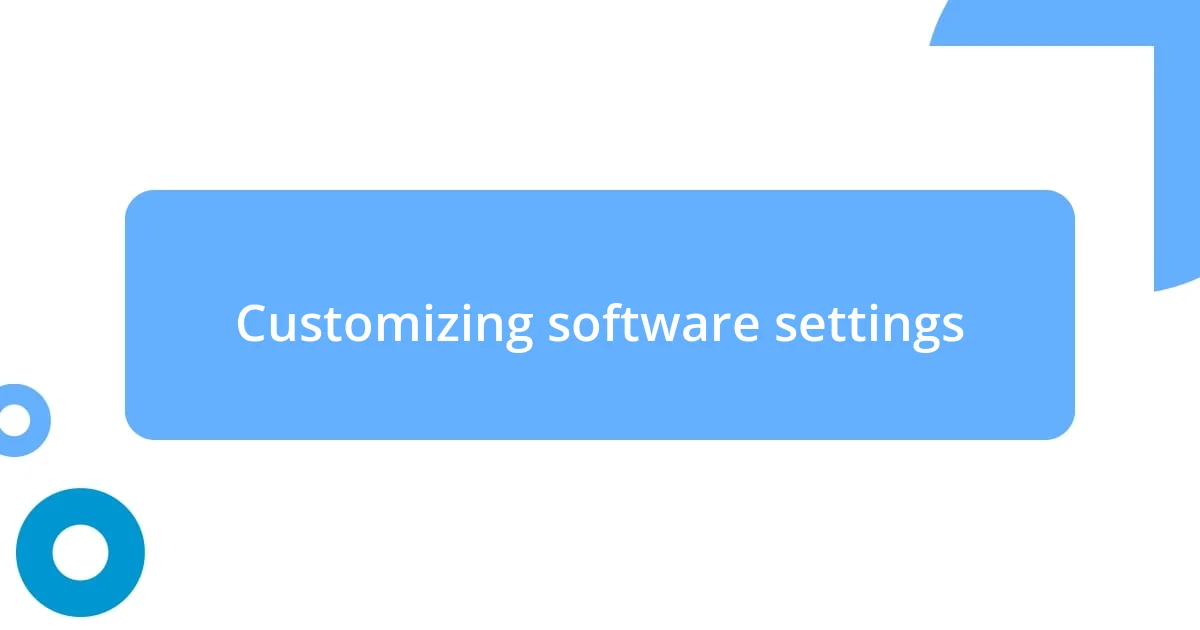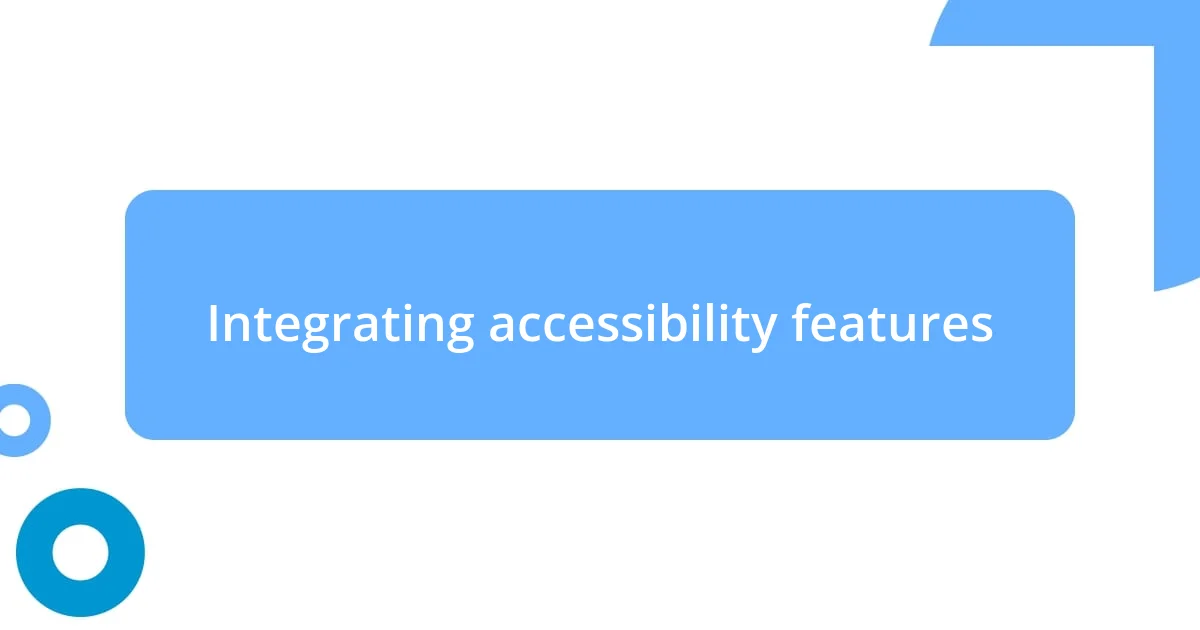Key takeaways:
- Customization of assistive technology, like adjusting settings for usability, significantly enhances accessibility and user experience.
- Integrating compatible devices and exploring various accessibility features can lead to improved efficiency and independence in daily tasks.
- Regular maintenance, updates, and engagement with support communities are essential for optimizing assistive technology performance and troubleshooting issues effectively.

Understanding assistive technology
Assistive technology encompasses a wide range of tools designed to enhance learning, communication, and daily living for individuals with disabilities. I remember when I first encountered screen readers; it was like a light bulb went off in my mind. Suddenly, the vast world of information online was accessible, transforming my experience of the internet from isolating to empowering.
There’s something incredibly powerful about tailoring these technologies to fit our unique needs. I once struggled to use a basic speech recognition program, feeling frustrated and defeated until I took the time to adjust the settings. By refining the sensitivity, I found that I could communicate more freely, and it provided me with a renewed sense of independence. Have you ever considered how customizations could enhance the effectiveness of your assistive tools?
Understanding assistive technology isn’t just about the devices themselves; it’s about how they can change the way we interact with the world. I often reflect on the emotions I felt when I first connected my adaptive keyboard; it was a game-changer, allowing me to type without discomfort. If assistive technology has the potential to open new doors for us, shouldn’t we take the time to truly explore its possibilities?

Factors for personalized setup
When I think about the factors that influence my personalized assistive tech setup, I realize the significance of my individual needs. For instance, the lighting in my workspace affects how well I can use my screen reader; in dim light, I find certain features hard to distinguish. I’ve learned the importance of not just the tools I use, but also the environment in which I use them.
Another factor is the type of tasks I frequently engage in. I remember when I transitioned to using speech-to-text software for writing my notes. At first, it didn’t understand my accent and would misinterpret words, which was frustrating. But as I spent time training it to recognize my voice, it improved dramatically, transforming a previously cumbersome process into a smooth and enjoyable experience.
Lastly, the integration of my assistive technology with other devices can significantly enhance functionality. I once integrated my smartphone with my adaptive keyboard and was amazed by how seamlessly they worked together. This synergy not only made it easier to manage tasks but also made me feel more independent and capable in my daily life.
| Factor | Description |
|---|---|
| Individual Needs | Personal requirements influence how tools are used effectively. |
| Task Type | The nature of tasks shapes the customization of technology for optimal performance. |
| Device Integration | Collaboration between devices enhances the overall assistive technology experience. |

Selecting the right devices
When selecting the right devices for my assistive technology setup, I prioritize comfort and functionality. For example, I once spent hours researching ergonomic mice because I was tired of hand pain after long sessions of computer work. After trial and error, I discovered a vertical mouse that felt completely natural in my hand. The difference was remarkable; not only did it improve my comfort, but it also made me more productive.
Choosing assistive devices can be overwhelming, but I find a practical approach helps. Here’s what I’ve learned to consider:
- Comfort: Look for devices that feel good in your hand. You’d be surprised how much a difference this makes over long periods.
- Functionality: Ensure the device meets your specific needs. Whether it’s text-to-speech software or an adaptive touchscreen, it should enhance your capabilities.
- Compatibility: Check if the devices work well with your existing technology. I experienced frustration when my new screen magnifier didn’t integrate smoothly with my tablet.
Taking the time to research and test different options has not only helped me find the right fit but has also increased my enthusiasm for using technology to empower my daily life.

Customizing software settings
When it comes to customizing software settings, I often find myself diving deep into the options available. For instance, I vividly remember the moment I discovered text-to-speech settings I could adjust for speech rate and pitch. Tweaking these settings made a world of difference—not only could I understand the speech more easily, but it also felt more natural to my ears. Have you ever thought about how such small adjustments could change your entire experience?
I also take time to modify accessibility features like contrast and font sizes. There was a time when my screen’s default text was hard to read, leading to significant eye strain. Once, I adjusted the font size and switched to a high-contrast mode, and suddenly, everything became clearer and more comfortable. It was like flipping a switch that illuminated my workspace, making me wonder why I hadn’t made these changes sooner.
Regularly revisiting my software settings is a practice I’ve grown fond of. I remember one instance where an update introduced new features, and I was initially overwhelmed. However, after exploring these settings through trial and error, I found tools that streamlined my workflow. This experience taught me that staying curious about customization can ensure my setup evolves alongside my needs. Have you explored the depths of your software settings lately? There’s always something new waiting to enhance your experience!

Integrating accessibility features
Integrating accessibility features into my assistive tech setup is something I view as a crucial step to enhance my daily interactions with technology. I recall feeling incredibly frustrated when I first encountered a voice command feature that didn’t quite understand my accent. After adjusting the settings for language and speech recognition, I experienced a thrilling sense of empowerment—it was like finally finding the key that unlocked a whole new world of convenience!
One of the most impactful features I’ve integrated is the screen reader. The first time I used it, I was amazed at its ability to read aloud my emails and articles, making it much easier to stay on top of everything. I remember thinking, “How did I manage without this?” Just being able to listen to information while multitasking has been such a game-changer for me. Have you ever considered how voice-related features can boost your productivity in a similar way?
Additionally, I consistently explore and implement options like keyboard shortcuts and gesture controls, which I initially overlooked. I still vividly recall a late-night session where I experimented with custom shortcuts for functions I used frequently. That feeling of accomplishment when I made my workflow more efficient was unmatched. It dawned on me that taking the initiative to personalize these features not only saved me time but also made my tech setup feel uniquely mine. What features can transform your tech experience for the better?

Testing and adjusting setup
Testing assistive tech setups requires dedication and a willingness to think outside the box. I remember the first time I integrated my new keyboard with various assistive tools. I spent an afternoon experimenting with different layouts and settings, reshaping my workflow until I found a rhythm that felt right. Have you ever lost track of time while tweaking your setup to make it work just the way you want?
One aspect I often focus on is testing how different features interact with one another. For example, I once discovered that my screen reader would misinterpret certain commands when I had my high-contrast settings activated. It was frustrating at first, but through trial and error, I learned which settings needed to be adjusted for a smoother experience. This realization sparked a sense of pride in understanding my tech better—who knew that these complicated setups could be peeled back to reveal a user-friendly experience with the right tweaks?
I also take the time to regularly revisit and reassess my assistive technology’s performance. Just the other week, I noticed my voice recognition software wasn’t responding as effectively as before, leading to misinterpretations during tasks. Diving into the settings, I discovered calibration options I hadn’t previously considered. After making those small adjustments, my software’s accuracy skyrocketed, reminding me that continual testing and tuning is essential for maintaining an optimal setup. What small adjustments could you explore that might lead to significant improvements in your digital life?

Maintaining and updating technology
Maintaining technology is an ongoing journey that requires vigilance and a proactive mindset. Just last month, I noticed my screen reader was lagging, causing delays that slowed my workflow. Rather than dismissing it, I dove into the settings, and after refreshing my software and updating the preferences, I felt a sense of relief wash over me as the speed and efficiency returned. Isn’t it fascinating how a simple update can drastically improve functionality?
Regularly checking for updates is essential, especially when my tools are important for navigating daily tasks. I still recall a moment when I hesitated to update a key app because I feared changes would disrupt my workflow. However, after finally taking the plunge and updating, I discovered new features that enhanced my user experience in ways I hadn’t imagined. Have you ever been surprised at how much you gain from what you initially feared?
I also believe in the importance of staying connected with support communities and forums. Last year, I encountered an issue with my voice command software that rendered it almost unusable. A fellow user in an online group suggested a patch I hadn’t considered. Implementing that solution transformed my setup from frustrating to seamless. It confirmed my belief that collaboration and sharing experiences can lead to powerful improvements. What community resources might you tap into to elevate your assistive tech experience?














